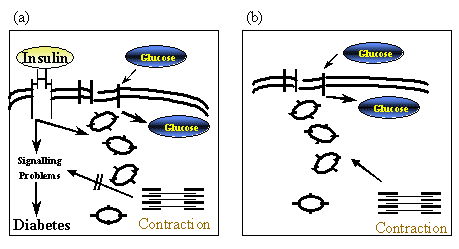| 2003 |

|
YEAR BOOK |
Dublin City University
|
Insulin signalling and glucose transport in Type 2 diabetes
|

The enhancement of insulin sensitivity is a key component in the treatment of patients with Type 2 diabetes. While few pharmacological treatments exist, skeletal muscle contraction is known to enhance glucose uptake. We, amongst others, have shown that insulin mediated glucose disposal is enhanced in response to exercise training. In a comparison of sedentary and exercise trained subjects we found that glucose disposal was significantly greater in the trained group. The activity of PI3-K, a key regulatory enzyme, was also significantly greater and positively correlated with glucose disposal. Interestingly, a single bout of exercise can also confer a significant improvement in glucose disposal, an effect that lasts for 24-72 hours. Therefore, exercise appears to result in rapid but transient improvements in skeletal muscle.
If exercise improves insulin mediated glucose transport, it is also important to assess the role of this pathway during exercise, as glucose uptake is also increased under these conditions. We found that PI3-K activity was decreased immediately at the end of exercise and 30-minutes post exercise. Even when these individuals were provided with carbohydrate after exercise, PI3-K activity was still significantly lower than when the same drink was consumed without exercise. Therefore, muscle contraction leads to an increase in glucose disposal, independent of insulin action, and has opened an intensive search for alternative pathways for GLUT-4 translocation.
Our laboratory is focused on studying the mechanisms regulating glucose transport in human skeletal muscle. The use of exercise as a model has proved very useful in the study of insulin resistance as it provides a physiological enhancement of the cellular and molecular response. It also has the advantage of providing novel or alternative signalling pathways to target treatment. This work is done in collaboration with Professor John Nolan at St James's Hospital, Dublin, and Professor Juleen Zierath at the Karolinska Institute, Stockholm.
Contact: Donal O'Gorman; Tel: 01-7008060; E-mail: [email protected]